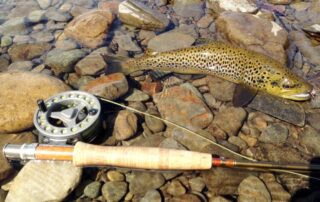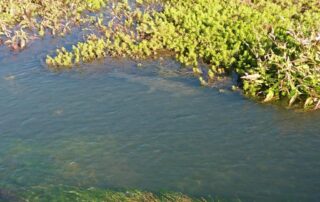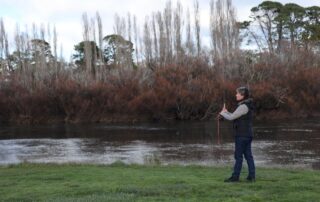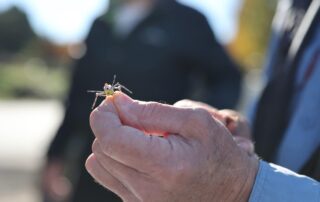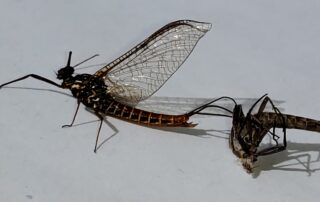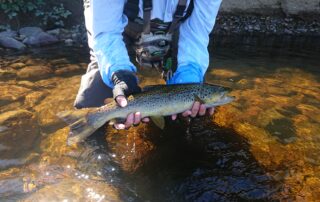From the clear waters of the Mersey River
Below Lees Paddocks on the clear waters of the Mersey River, these fish lie in wait in shady pockets and near undercut banks for the occasional grasshopper as they gather condition for the rigors of spawning that are not far away. With light wind conditions out come the four weight fly rods. The fly is a hopper pattern. Image: Gary France, Trout Territory
Lying in wait
In a northern midlands river, a wild trout lies in wait on a narrow flowing channel. A single bow and arrow cast with a grasshopper landed with a splat resulted in a solid hookup. An 8lb tippet was used to get the fish in quickly and released without harm. When water temperatures are above 20 deg Celsius it's really important to give these fish a good chance of survival, so minimal time out of the water. Image by Gary France
Basic fly cast
Here is the highly valuable lift up and lay down single cast. Note the rod on the back stroke STOP is vertical at 12 o'clock. This throws the line high, setting up for a good forward stroke. When beginners to fly fishing come fishing with us, we teach casting basics on the grass first. The we add water!
Grasshopper
Here's a grasshopper fly. Into the warmest months of Tasmania's summer, grasshoppers are a feature on rivers and lakes. This is a foam bodied hopper that will float all day, and imparted with the right sort of movement, twitch twitch, bringing it to life, is a highly effective dry fly technique.
Life Cycle of the Tasmanian Mayfly
In Tasmania, developing a sense around what trout foods are available, where and when, increases the chances for success. Mayfly are in full swing from September/October on the lakes and rivers of the lowlands. The highlands follows a little later due to its altitude and climate. These mayfly hatches continue through to around March, peaking again on the lowlands through to the end of April and the season's close. Altitude plays a major role along with water and air temperature; changing light conditions, i.e. cloud cover; and wind and climate. Nymph The Nymph Nymphs live in the water [...]
Leven River, Tasmania
The upper reaches of the River Leven, not far from Cradle Mountain, rise through sink holes just like the Vale River and they are both on opposite sides of the range. The water of the Leven is very light tannin, and the Leven is one of the only rivers in Tasmania with no dams on it. It also has the highest values for macro invertebrate counts. There are good numbers of Mayfly and this is used as a scientific indicator to show the quality of a river system. There is Anglers Access at Loongana, a section which is open from [...]
Fishing Safety
Fishing Safety Be safe when fishing in Tasmania. Respect the sun when you go trout fishing. The UV is more intense in Tasmania, even on overcast days. Be sure to bring along sunscreen. We also provide sunscreen for our clients. Essential items when trout fishing in Tasmania: Sunscreen, hat, sunglasses. Protect your eyes Protecting your eyes when trout fishing with polaroid or safety glasses is highly recommended. If you don't have them, we have polaroid sunglasses to loan to our clients. Be prepared for any weather When fishing in Tasmania, it is a good idea to bring along warm clothing. [...]
Disease Free Tasmania
Disease Free Tasmania We are all responsible for keeping Tasmania a disease free fishery. To ensure the future of Tasmania's stunning wild trout fishery, it is vital that we are all aware of what we can do to ensure Tasmania remains a disease free fishery. Please help keep Didymo and other diseases out of Tasmania This information is sourced from Tasmanian Inland Fisheries Service. Here is a description of the Didymo algae and how you can avoid its spread. Didymo (Didymosphenia geminata) is a freshwater diatom (algae) that can cause massive algal blooms on the beds of streams, rivers, and [...]
Catch & Release
Catch & Release Safely release a wild trout back to the water A little TLC please! We enjoy eating fresh caught trout, keeping only what we intend to eat. We promote catch and release, and if we are going to release our wild trout, we need to ensure that we do so in a manner that gives it the best possible chance of survival. Handing and releasing wild trout Here are some guidelines that we follow when handling and releasing wild trout. Keep in mind that a trout has a better chance of survival after release if the trout is [...]
Polaroid for trout
Polaroid for trout Some Polaroiding facts: Polaroid sunglasses reduce the effects of glare on the water surface providing a better view of objects within. The best polaroiding time for trout fishing in Tasmania is approximately between10am and 2pm. The best position to be in when polaroiding is to work a line between the direction of sunlight from behind and the direction of the wind from behind. Try to find a happy medium. Polaroid glasses are treated to enhance contrast and this is probably where spending a few more dollars on a pair of quality polaroid sunglasses will pay larger dividends [...]

